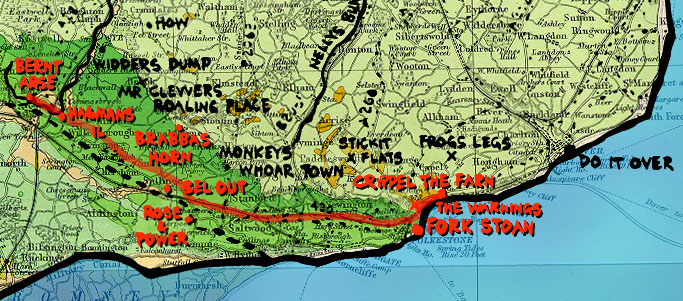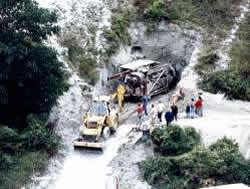
University of California, Irvine
Instructor: Dr. Barbara J. Becker

|
Week 4. Riddley Guide
|
If you haven't stumbled on it already, check out Eli Bishop's terrific Riddley Walker Annotations website!
Page 90. "So we Souf and Eastit then for Fork Stoan..." |

Page 90. "Nearing on to Bernt Arse
[Ashford] outers we come thru some old bernt over common it use to be a
fents there long time back but long since emty gone to scrub and runty
woodling they callit Hagmans Il [Hinxhill]."
|
The name Hinxhill derives from the Old English hengest meaning "stallion". The town's name was first recorded as Haenostesyle in about 1100. According to legend, Saxon-born Hengest and his brother Horsa fled to the British Isles in the fifth century. For a time, Hengest served as a mercenary for Vortigern, King of the Britons. There are many versions of Hengest's adventures and conquests, including the one recorded in The Anglo-Saxon Chronicle (9th c; see below). Most accounts agree that Hengest was the first ruler of Kent and that his daughter married King Vortigern. In time, Hengest called on other Saxons to join him in the British Isles. Hengest's and Vortigern's once-friendly relationship deteriorated as tension led to hostilities between the indigenous Britons and the growing numbers of Saxon newcomers. |
|
"Hengest and Horsa"
A.D. 435. This year the Goths sacked the city of Rome; and never since have the Romans reigned in Britain. This was about eleven hundred and ten winters after it was built. They reigned altogether in Britain four hundred and seventy winters since Gaius Julius first sought that land. A.D. 443. This year sent the Britons over sea to Rome, and begged assistance against the Picts; but they had none, for the Romans were at war with Atila, king of the Huns. Then sent they to the Angles, and requested the same from the nobles of that nation. A.D. 444. This year died St. Martin. A.D. 448. This year John the Baptist showed his head to two monks, who came from the eastern country to Jerusalem for the sake of prayer, in the place that whilom was the palace of Herod. A.D. 449. This year Marcian and Valentinian assumed the empire, and reigned seven winters. In their days Hengest and Horsa, invited by Wurtgern, king of the Britons to his assistance, landed in Britain in a place that is called Ipwinesfleet; first of all to support the Britons, but they afterwards fought against them. The king directed them to fight against the Picts; and they did so; and obtained the victory wheresoever they came. They then sent to the Angles, and desired them to send more assistance. They described the worthlessness of the Britons, and the richness of the land. They then sent them greater support. Then came the men from three powers of Germany; the Old Saxons, the Angles, and the Jutes. From the Jutes are descended the men of Kent, the Wightwarians (that is, the tribe that now dwelleth in the Isle of Wight), and that kindred in Wessex that men yet call the kindred of the Jutes. From the Old Saxons came the people of Essex and Sussex and Wessex. From Anglia, which has ever since remained waste between the Jutes and the Saxons, came the East Angles, the Middle Angles, the Mercians, and all of those north of the Humber. Their leaders were two brothers, Hengest and Horsa; who were the sons of Wihtgils; Wihtgils was the son of Witta, Witta of Wecta, Wecta of Woden. From this Woden arose all our royal kindred, and that of the Southumbrians also.... A.D. 455. This year Hengest and Horsa fought with Wurtgern the king on the spot that is called Aylesford. His brother Horsa being there slain, Hengest afterwards took to the kingdom with his son Esc. A.D. 457. This year Hengest and Esc fought with the Britons on the spot that is called Crayford, and there slew four thousand men. The Britons then forsook the land of Kent, and in great consternation fled to London. A.D. 465. This year Hengest and Esc fought with the Welsh, nigh Wippedfleet; and there slew twelve leaders, all Welsh. On their side a thane was there slain, whose name was Wipped. A.D. 473. This year Hengest and Esc fought with the Welsh, and took immense Booty. And the Welsh fled from the English like fire. A.D. 477. This year came Ella to Britain, with his three sons, Cymen, and Wlenking, and Cissa, in three ships; landing at a place that is called Cymenshore. There they slew many of the Welsh; and some in flight they drove into the wood that is called Andred'sley. A.D. 482. This year the blessed Abbot Benedict shone in this world, by the splendour of those virtues which the blessed Gregory records in the book of Dialogues. A.D. 485. This year Ella fought with the Welsh nigh Mecred's-Burnsted. A.D. 488. This year Esc succeeded to the kingdom [on the death of Hengest]; and was king of the men of Kent twenty-four winters. |
Page 93. "...when Wayman Footling tol me that story I askit him, 'Be that realy how that place got its name?' He said, No not realy..."
|
Page 94. "1ce we got a good offing from Bernt Arse we come down be twean Brabbas Horn [Brabourne] and Sel Out [Sellindge] Form.... We come on to the A20 [the main highway heading toward Folkestone]..." Page 95. "By then wed come off the A20 we wer on what they call the Iron Track [railway line]..."
Page 96. "Come the nex litening flash I seen a old stoan rune I knowit the place they callit Rose & Power [Rosamund's Bower] it ben from wel befor time back way back. It wer mosly jus a jumbl of stoans ben dug out here and there for sheltering 1 time and a nother."
Fair Rosamund's Tower, or Rosamund's Bower ("bower"--in
this case--meaning "a lady's boudoir")
Rosamund's Tower is part of Westenhanger Castle, the remains of which are located near the Folkestone Race Course. It is named for Rosamund de Clifford (c.1137-1176), known as Rosamund the Fair, whose secret amorous relationship with King Henry II (1133-1189) became the stuff of romantic legends. While it's possible that Rosamund spent some time at Westenhanger Castle, there is no evidence that she was ever "embowered" there by Henry. According to some accounts, Rosamund was slain, or forced to take her own life, by Henry's jealous wife, Queen Eleanor of Aquitaine (c. 1122-1204), but it seems more likely that she died of natural causes at a nunnery in Godstow, Oxfordshire.
Page 99. "We wer farther in [the city of Folkestone] nor ever I ben when I ben littl we kep on thru hevvy rubble til we come in unner some thing and out of the rain. Cudnt see nothing at all in there. Gone a littl farther and come to big steps going down and warm air coming up." The main railway line in Folkestone enters a tunnel near a section of cliff-bordered shoreline called The Warren [in Riddley-speak: The Warnings]. Could the railway tunnel be what Riddley is describing when he writes that "we come in unner some thing and out of the rain"? Page 99. "That place wer a Power place you cud feal it all roun you.... "The jynt shadders wer from girt machines o they wer guvner big things and crouching all broakin but not dead they cudnt dy there wer too much Power in them. Where we were stanning you cud hear the sea beyont us in the dark" Page 100. "...they wer some kynd of iron dint rot it wer all shyning all catching that shaky glimmer. Some of them ther shels ben broak open you cud see girt shyning weals like jynt mil stoans only smoov." The chalky cliffs between Folkestone and Dover contain numerous tunnels, caves, and other structures--many of them were built to defend England's vulnerable coast from enemy attack, some were dug to carry water pipes, others show evidence of having been mining sites. Periodically over the past two centuries, large-scale projects have been undertaken to construct a tunnel under the English Channel to connect England with the Continent. In 1994, this goal was finally realized with the opening of the Channel Tunnel. When Russell Hoban was writing Riddley Walker, the history of earlier tunneling efforts could be brought to life by exploring long-abandoned tunnels in The Warren and examining the equipment crews had left behind.
The boring machine at work on the Folkestone tunnel test in 1922. In 1919, interest in a Channel tunnel was revived long enough to propose digging a test tunnel in The Warren (not far from the entrance to the main railway tunnel). Unfortunately, the 31-ton behemoth built to accomplish this task only got about 490 ft into the cliff before work was stopped in 1922.
The abandoned 1922 boring machine. Did the sight of this machine inspire Riddley's comments in ch 12? It seems that Parliament had a change of heart about the risks v.
advantages of being connected to the Continent. The boring machine
remained where it had been abandoned until it was removed and restored
in 1985.
|

Workmen from the Graham J. Allen Company pull the abandoned machine out of the chalk.
|
By 1974, hopes for another Channel Tunnel venture led to another test run, this time at the site of an abandoned 1881 tunnel project at Shakespeare Cliff, a few miles up the coast toward Dover. When work was halted in 1975, the boring machine had dug over 2000 feet.
Workers examine the tunnel boring machine they will
use to dig into Shakespeare Cliff.
A whirling modern tunnel boring machine. How
do you think Riddley would have responded if he found something like this?
Or this?--one of the tungsten-toothed tunnel boring machines used to dig the Channel Tunnel.
Page 100. "O what we ben! And what we come to!" Was there ever a time that you felt completely awestruck by the ingenuity embodied some manmade object, structure or process? What do you think it was that so inspired you?
Page 102. "...we gone down some steps in to a tunnel and you cud hear the sea stronger. We come out in to the open nite and the littl girzel on our faces agen the sea wer beating loud on the stoans it wer hy water right a nuff. When we come out then it wer some where a long the snug I think it wer just inshoar of the lite house stump."
Near the entrance (now kept securely locked) to one of the tunnels dug into the cliffs along The Warren in the 1880s to test the feasibility of building a tunnel under the English Channel.
Page 103. "We come to where the clifsve fel in to the sea time back way back its broakin groun there all a jumbl we use to go there our crowd of kids when I ben littl. That place stil had its old name from way back it wer callit The Warnings [The Warren]."
Looking down on The Warnings [The Warren] towards Fork
Stoan [Folkestone] from the top of the cliffs near Crippel the Farn [Capel-le-Ferne].
For more photos and information on early Channel tunnel works and other structures built along England's Channel coastline from the time of Napoleon to the present, see:
Page 104. "...a bag of littl stoans all wet and crummly. Not hard at all you cud break them with your thum nail."
"This is what I ben lissening."--Lissener |
|